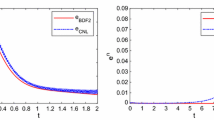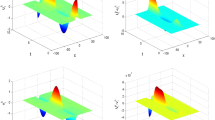Abstract
In this paper, a fast temporal second-order compact ADI scheme is proposed for the 2D time multi-term fractional wave equation. At the super-convergence point, the multi-term Caputo derivative is approximated by combining the order reduction technique with the sum-of-exponential approximation to the kernel function appeared in Caputo derivative. The difference scheme can be solved by the recursion, which reduces the storage and computational cost significantly. The obtained scheme is uniquely solvable. The unconditional convergence and stability of the scheme in the discrete H1-norm are proved by the discrete energy method and the convergence accuracy is second-order in time and fourth-order in space. Numerical example illustrates the efficiency of the scheme.
Similar content being viewed by others
References
Abdel-Rehim, E.A., El-Sayed, A.M.A., Hashem, A.S.: Simulation of the approximate solutions of the time-fractional multi-term wave equations. Comput. Math. Appl. 73, 1134–1154 (2017)
Alikhanov, A.A.: A new difference scheme for the fractional diffusion equation. J. Comput. Phys. 280, 424–438 (2015)
Bhrawy, A.H., Zaky, M.A.: A method based on the Jacobi tau approximation for solving multi-term time-space fractional partial differential equations. J. Comput. Phys. 281, 876–895 (2015)
Dehghan, M., Abbaszadeh, M., Deng, W.H.: Fourth-order numerical method for the space-time tempered fractional diffusion-wave equation. Appl. Math. Letters 73, 120–127 (2017)
Dehghan, M., Safarpoor, M., Abbaszadeh, M.: Two high-order numerical algorithms for solving the multi-term time fractional diffusion-wave equations. J. Comput. Appl. Math. 290, 174–195 (2015)
Du, R., Cao, W., Sun, Z.Z.: A compact difference scheme for the fractional diffusion-wave equation. Appl. Math. Model. 34, 2998–3009 (2010)
Donatelli, M., Mazza, M., Serra-Capizzano, S.: Spectral analysis and structure preserving preconditioners for fractional diffusion equations. J. Comput. Phys. 307, 262–279 (2016)
Gao, G.H., Alikhanov, A.A., Sun, Z.Z.: The temporal second order difference schemes based on the interpolation approximation for solving the time multi-term and distributed-order fractional sub-diffusion equations. J. Sci. Comput. 73, 93–121 (2017)
Gao, G.H., Yang, Q.: Fast evaluation of linear combinations of Caputo fractional derivatives and its applications to multi-term time-fractional sub-diffusion equations, Numer. Math.: Theory, Methods and Appl. https://doi.org/10.4208/nmtma.OA-2019-0013 (2020)
Godoy, S., Garcia-Colin, L.S.: From the quantum random walk to classical mesoscopic diffusion in crystalline solids. Phys. Rev. E 53, 5779–5785 (1996)
Jiang, S.D., Zhang, J.W., Zhang, Q., Zhang, Z.M.: Fast evaluation of the Caputo fractional derivative and its applications to fractional diffusion equations. Commun. Comput. Phys. 21, 650–678 (2017)
Jin, B., Lazarov, R., Liu, Y., Zhou, Z.: The Galerkin finite element method for a multi-term time-fractional diffusion equation. J. Comput. Phys. 281, 825–843 (2015)
Lei, S.L., Sun, H.W.: A circulant preconditioner for fractional diffusion equations. J. Comput. Phys. 242, 715–725 (2013)
Li, C.P., Cao, J.X.: A finite difference method for time-fractional telegraph equation. In: 2012 IEEE /ASME International Conference, pp. 314–318
Liu, F., Meerschaert, M.M., McGough, R.J., Zhuang, P., Liu, Q.: Numerical methods for solving the multi-term time-fractional wave-diffusion equation. Fract. Calc. Appl. Anal. 16, 9–25 (2013)
Luchko, Y.: Initial-boundary-value problems for the generalized multi-term time-fractional diffusion equation. J. Math. Anal. Appl. 374, 538–548 (2011)
Oldham, K.B., Spanier, J.: The Fractional Calculus. Academic Press, San Diego (1974)
Quarteroni, A., Valli, A.: Numerical Approximation of Partial Differential Equations. Springer, New York (1997)
Ren, J.C., Sun, Z.Z.: Efficient Numerical solution of the multi-term time fractional diffusion-dave equation. East Asian J. Appl. Math. 5, 1–28 (2015)
Salehi, R.: A meshless point collocation method for 2-D multi-term time fractional diffusion-wave equation. Numer Algor. 74, 1145–1168 (2017)
Shiralashetti, S.C., Deshi, A.B.: An efficient Haar wavelet collocation method for the numerical solution of multi-term fractional differential equations. Nonlinear Dyn. 83, 293–303 (2016)
Srivastava, V., Rai, K.N.: A multi-term fractional diffusion equation for oxygen delivery through a capillary to tissues. Math. Comput. Model. 51, 616–624 (2010)
Sun, H.G., Li, Z.P., Zhang, Y., Chen, W.: Fractional and fractal derivative models for transient anomalous diffusion: model comparison. Chaos, Solitons & Fractals 102, 346–353 (2017)
Sun, H.G., Zhang, Y., Chen, W., Reeves, D.M.: Use of a variable-index fractional-derivative model to capture transient dispersion in heterogeneous media. J. Contam. Hydrol. 157, 47–58 (2014)
Sun, Z.Z.: Numerical Methods of Partial Differential Equations, 2nd edn. Science Press, Beijing (2012). in Chinese
Sun, H., Sun, Z.Z., Gao, G.H.: Some temporal second order difference schemes for fractional wave equations. Numer. Methods Partial Differential Eq. 32, 970–1001 (2016)
Sun, Z.Z., Wu, X.: A fully discrete difference scheme for a diffusion-wave system. Appl. Numer. Math. 56, 193–209 (2006)
Sun, H., Zhao, X., Sun, Z.Z.: The temporal second order difference schemes based on the interpolation approximation for the time multi-term fractional wave equation. J Sci Comput. 78, 467–498 (2019)
Tian, W., Zhou, H., Deng, W.: A class of second order difference approximations for solving space fractional diffusion equations. Math. Comput. 84, 1703–1727 (2015)
Vong, S.W., Pang, H.K., Jin, X.Q.: A high-order difference scheme for the generalized Cattaneo equation. East Asian J. Appl. Math. 2, 170–184 (2012)
Wang, Z.B., Vong, S.: Compact difference schemes for the modified anomalous fractional sub-diffusion equation and the fractional diffusion-wave equation. J. Comput. Phys. 277, 1–15 (2014)
Pan, J., Ng, M.K., Wang, H.: Fast iterative solvers for linear systems arising from timedependent space-fractional diffusion equations. SIAM J. Sci. Comput. 38, A2806–A2826 (2016)
Yan, Y.G., Sun, Z.Z., Zhang, J.W.: Fast evaluation of the Caputo fractional derivative and its applications to fractional diffusion equations: a second-order scheme. Commun. Comput. Phys. 22, 1028–1048 (2017)
Zhang, Y.N., Sun, Z.Z., Zhao, X.: Compact alternating direction implicit schemes for the two-dimensional fractional diffusion-wave equation. SIAM J. Numer. Anal. 50, 1535–1555 (2012)
Zhao, X., Sun, Z.Z.: Compact Crank-Nicolson schemes for a class of fractional Cattaneo equation in inhomogeneous medium. J. Sci. Comput. 62, 747–771 (2015)
Zhao, X., Sun, Z.Z., Karniadakis, G.E.: Second-order approximations for variable order fractional derivatives: algorithms and applications. J. Comput. Phys. 293, 184–200 (2015)
Funding
The research is supported by the National Natural Science Foundation of China (grant number 11701229, 11671081), Natural Science Youth Foundation of Jiangsu Province (No. BK20170567), China Postdoctoral Science Foundation (No. 2019M651634), High-level Scientific Research foundation for the introduction of talent of Nanjing Institute of Technology (No. YKL201856).
Author information
Authors and Affiliations
Corresponding author
Additional information
Publisher’s note
Springer Nature remains neutral with regard to jurisdictional claims in published maps and institutional affiliations.
Appendix. The proof of Theorem 2
Appendix. The proof of Theorem 2
Firstly, we present some lemmas which are necessary for proving Theorem 2.
Lemma 9
[8] Given any non-negative integer m and positive constants λ0,λ1,…,λm, for any γi ∈ (0, 1],i = 0, 1,…,m, it holds
In addition, there exists a constant τ0 such that when τ ≤ τ0,
and hence
Lemma 10
The sequence \(\{\widehat {g}_{n}^{(k+1)}\}\) satisfies
and
Proof
Similar to the derivation of Corollary 2 in [2], \(\{a_{n}^{(\gamma _{r})}\}\) and \(\{b_{n}^{(\gamma _{r})}\}\) have the relation \(b_{n}^{(\gamma _{r})}=a_{n}^{(\gamma _{r})}\Big (\kappa ^{(\gamma _{r})}_{n}-\frac {1}{2}\Big ),\) where \(\frac {1}{2}\leq \kappa ^{(\gamma _{r})}_{n}\leq \frac {1}{2-\gamma _{r}}.\)□
It follows that
For the second inequality, we have
Similar to the derivation of Lemma 4.1 in [33], we can obtain the following lemma.
Lemma 11
The sequences \(\{g_{n}^{(k+1,\gamma _{r})}\}\) and \(\{{~}^{\mathcal {F}}g_{n}^{(k+1,\gamma _{r})}\}\) satisfy
and for k ≥ 1,
Lemma 12
[9] For the coefficients \(\big \{{~}^{\mathcal {F}}\widehat {g}_{n}^{(k+1)} (0\leq n\leq k, 0\leq k\leq N-1)\big \}\) defined in (8), and a sufficiently small ε, it holds
In addition, there exists a constant τ0 such that, when τ ≤ τ0,
and hence
where C is a positive constant.
Lemma 13
The sequence \(\{{~}^{\mathcal {F}}\widehat {g}_{n}^{(k)}\}\) satisfies
where \(\widehat {B}_{k-1}=\sum \limits _{r=0}^{m}\lambda _{r}^{(\gamma _{r})}\Big (\sum \limits _{l=1}^{N_{exp}^{(\gamma _{r})}}\hat {\omega }_{1}^{(\gamma _{r})}e^{-(k-1)s_{l}^{(\gamma _{r})}\tau }B_{l}^{(\gamma _{r})}\Big ).\) In addition,
and
where κ1 is a positive constant.
Proof
The relation between \(\{{~}^{\mathcal {F}}{\widehat {g}}_{n}^{(k+1)}\}\) and \(\{{~}^{\mathcal {F}}{\widehat {g}}_{n}^{(k)}\}\) is obvious. We omit the details. □
It follows from Lemma 11 that
where κ1 is a constant. By Lemma 10 and noticing that \(\widehat {B}_{n-1}\leq {~}^{\mathcal {F}}\widehat {g}_{n-1}^{(n+1)} ~(1\leq n\leq k),\) it yields
and
The coefficients \(\{{~}^{\mathcal {F}}g_{n}^{(k+1,\gamma _{r})}\}\) defined in (8) have the similar property as \(\{g_{n}^{(k+1,\gamma _{r})}\}\); thus, we have the following lemma.
Lemma 14
[8] Suppose 〈⋅,⋅〉∗ is an inner product on \(\mathcal {U}_{h},\) ∥⋅∥∗ is its deduced norm. For any grid functions \(v^{0},v^{1},\ldots ,v^{k+1}\in \mathcal {U}_{h},\) we have the following inequality
Lemma 15
[26] For any grid functions \(u^{0},u^{1},\ldots ,u^{N}\in \mathcal {U}_{h}\), we have the following inequality
with
In addition, it holds
The proof of Theorem 2
. The proof is divided into two steps, which correspond to the case k = 0 and k ≥ 1. □
It follows from (62)–(65) that \(~~~~u_{ij}^{k}=0,~~v_{ij}^{k}=0, \quad (i,j)\in \partial \omega ,~~0\leq k\leq N.\) Consequently,
-
Step 1. When k = 0, the system is as follows
$$ \begin{array}{@{}rcl@{}} &&\mathcal{A}{~}^{\mathcal{F}}\widehat{g}_{0}^{(1)}(v_{ij}^{1}-v_{ij}^{0}) +\frac{\sigma^{2}\tau^{2}}{4p_{0}}{\delta_{x}^{2}}{\delta_{y}^{2}}v_{ij}^{1} =\sigma{\Lambda}_{h}u_{ij}^{1}+(1-\sigma){\Lambda}_{h}u_{ij}^{0}\\ &&\qquad\qquad\qquad\qquad\qquad\qquad\quad\qquad +p_{ij}^{0},~(i,j)\in\omega, \end{array} $$(A.3)$$ \begin{array}{@{}rcl@{}} &&\delta_{t}u_{ij}^{\frac{1}{2}}=v_{ij}^{\frac{1}{2}}+g_{ij}^{0},~(i,j)\in\overline{\omega}, \end{array} $$(A.4)$$ \begin{array}{@{}rcl@{}} &&u_{ij}^{0}=w_{1}(x_{i},y_{j}),~v_{ij}^{0}=w_{2}(x_{i},y_{j}),~(i,j)\in\overline{\omega}, \end{array} $$(A.5)$$ \begin{array}{@{}rcl@{}} &&u_{ij}^{1}=0,~(i,j)\in\partial\omega. \end{array} $$(A.6)
-
(1)
Taking the inner product of (A.3) with v1, we have
$$ \begin{array}{@{}rcl@{}} &&{~}^{\mathcal{F}}\widehat{g}_{0}^{(1)}\|v^{1}\|_{\mathcal{A}}^{2} +\frac{\sigma^{2}\tau^{2}}{4p_{0}}\|\delta_{x}\delta_{y}v^{1}\|^{2}\\ &=&{~}^{\mathcal{F}}\widehat{g}_{0}^{(1)}(\mathcal{A}v^{0},v^{1}) + \sigma\big({\Lambda}_{h}u^{1},v^{1}\big) + (1-\sigma)({\Lambda}_{h}u^{0},v^{1}) + (p^{0},v^{1}). \end{array} $$(A.7)From (A.4), we have
$$ \begin{array}{@{}rcl@{}} \delta_{t}{\Lambda}_{h}u_{ij}^{\frac{1}{2}}={\Lambda}_{h}v_{ij}^{\frac{1}{2}}+{\Lambda}_{h}g_{ij}^{0},~(i,j)\in\omega. \end{array} $$(A.8)Taking the inner product of (A.8) with − 2σu1 and by the summation by parts, it yields
$$ \begin{array}{@{}rcl@{}} -\frac{2\sigma}{\tau}({\Lambda}_{h}u^{1},u^{1}) &=&-\frac{2\sigma}{\tau}({\Lambda}_{h}u^{0},u^{1})-\sigma({\Lambda}_{h}v^{1},u^{1}) -\sigma({\Lambda}_{h}v^{0},u^{1})\\ &&-2\sigma({\Lambda}_{h}g^{0},u^{1}). \end{array} $$(A.9)Adding (A.7) with (A.9) and using (A.1), Young inequality, and Lemma 7, we obtain
$$ \begin{array}{@{}rcl@{}} &&{~}^{\mathcal{F}}\widehat{g}_{0}^{(1)}\|v^{1}\|_{\mathcal{A}}^{2} +\frac{\sigma^{2}\tau^{2}}{4p_{0}}\|\delta_{x}\delta_{y}v^{1}\|^{2} +\frac{4\sigma}{3\tau}(\|\delta_{x}u^{1}\|^{2}+\|\delta_{y}u^{1}\|^{2})\\ &\leq&{~}^{\mathcal{F}}\widehat{g}_{0}^{(1)}(\mathcal{A}v^{0},v^{1})+(p^{0},v^{1}) +(1-\sigma)({\Lambda}_{h}u^{0},v^{1})-2\sigma({\Lambda}_{h}g^{0},u^{1})\\ &&-\frac{2\sigma}{\tau}({\Lambda}_{h}u^{0},u^{1})-\sigma({\Lambda}_{h}v^{0},u^{1})\\ &\leq&\Big(\frac{{~}^{\mathcal{F}}\widehat{g}_{0}^{(1)}}{3}\|v^{1}\|_{\mathcal{A}}^{2} +\frac{3{~}^{\mathcal{F}}\widehat{g}_{0}^{(1)}}{4}\|v^{0}\|_{\mathcal{A}}^{2}\Big) +\Big(\frac{{~}^{\mathcal{F}}\widehat{g}_{0}^{(1)}}{9}\|v^{1}\|^{2}+\frac{9}{4{~}^{\mathcal{F}}\widehat{g}_{0}^{(1)}}\|p^{0}\|^{2}\Big)\\ &&+\Big(\frac{{~}^{\mathcal{F}}\widehat{g}_{0}^{(1)}}{9}\|v^{1}\|^{2} +\frac{9(1-\sigma)^{2}}{4{~}^{\mathcal{F}}\widehat{g}_{0}^{(1)}}\|{\Lambda}_{h}u^{0}\|^{2}\Big) +\Big({\delta}\|u^{1}\|^{2}+\frac{\sigma^{2}}{{\delta}}\|{\Lambda}_{h}g^{0}\|^{2}\Big)\\ &&+\Big({\delta}\|u^{1}\|^{2}+\frac{\sigma^{2}}{{\delta}\tau^{2}}\|{\Lambda}_{h}u^{0}\|^{2}\Big) +\Big({\delta}\|u^{1}\|^{2}+\frac{\sigma^{2}}{4{\delta}}\|{\Lambda}_{h}v^{0}\|^{2}\Big) \\ &\leq&{~}^{\mathcal{F}}\widehat{g}_{0}^{(1)}\|v^{1}\|_{\mathcal{A}}^{2}+3{\delta}\|u^{1}\|^{2} +\frac{3{~}^{\mathcal{F}}\widehat{g}_{0}^{(1)}}{4}\|v^{0}\|_{\mathcal{A}}^{2} +\frac{9(1-\sigma)^{2}}{4{~}^{\mathcal{F}}\widehat{g}_{0}^{(1)}}\|{\Lambda}_{h}u^{0}\|^{2} \\ &&+\frac{9}{4{~}^{\mathcal{F}}\widehat{g}_{0}^{(1)}}\|p^{0}\|^{2}+\frac{\sigma^{2}}{{\delta}}\|{\Lambda}_{h}g^{0}\|^{2}+\frac{\sigma^{2}}{{\delta}\tau^{2}}\|{\Lambda}_{h}u^{0}\|^{2} +\frac{\sigma^{2}}{4{\delta}}\|{\Lambda}_{h}v^{0}\|^{2}, \end{array} $$(A.10)where we use \(\|v^{1}\|^{2}\leq 3\|v^{1}\|_{\mathcal {A}}^{2}.\)
Using \(\|u^{1}\|^{2}\leq \frac {1}{\frac {6}{{L_{1}^{2}}}+\frac {6}{{L_{2}^{2}}}}(\|\delta _{x}u^{1}\|^{2}+\delta _{y}u^{1}\|^{2})\) and taking \({\delta }=\frac 1{9\tau }\cdot (\frac {6\sigma }{{L_{1}^{2}}}+\frac {6\sigma }{{L_{2}^{2}}}),\) we have
$$ \begin{array}{@{}rcl@{}} \|\delta_{x}u^{1}\|^{2}+\|\delta_{y}u^{1}\|^{2}&\leq& \frac{3{~}^{\mathcal{F}}\widehat{g}_{0}^{(1)}\tau}{4\sigma}\|v^{0}\|_{\mathcal{A}}^{2} +\frac{9(1-\sigma)^{2}\tau}{4{~}^{\mathcal{F}}\widehat{g}_{0}^{(1)}\sigma}\|{\Lambda}_{h}u^{0}\|^{2} \\ &&+\frac{9\tau}{4{~}^{\mathcal{F}}\widehat{g}_{0}^{(1)}\sigma}\|p^{0}\|^{2}+\frac{3\tau^{2}}{\frac{2}{{L_{1}^{2}}}+\frac{2}{{L_{2}^{2}}}}\|{\Lambda}_{h}g^{0}\|^{2} \\ &&+\frac{3}{\frac{2}{{L_{1}^{2}}}+\frac{2}{{L_{2}^{2}}}}\|{\Lambda}_{h}u^{0}\|^{2}\\ &&+\frac{3}{\frac{8}{{L_{1}^{2}}}+\frac{8}{{L_{2}^{2}}}}\tau^{2}\|{\Lambda}_{h}v^{0}\|^{2}. \end{array} $$(A.11) -
(2)
It follows from (A.8) that
$$ \begin{array}{@{}rcl@{}} {\Lambda}_{h}u_{ij}^{1}={\Lambda}_{h}u_{ij}^{0}+\tau{\Lambda}_{h}v_{ij}^{\frac{1}{2}}+\tau {\Lambda}_{h}g_{ij}^{0},~~(i,j)\in\omega. \end{array} $$(A.12)Substituting (A.12) into (A.3), we have
$$ \begin{array}{@{}rcl@{}} \mathcal{A}{~}^{\mathcal{F}}\widehat{g}_{0}^{(1)}(v_{ij}^{1}-v_{ij}^{0}) +\frac{\sigma^{2}\tau^{2}}{4p_{0}}{\delta_{x}^{2}}{\delta_{y}^{2}}v_{ij}^{1} &=&\sigma{\Lambda}_{h}u_{ij}^{0}+\sigma\tau{\Lambda}_{h}v_{ij}^{\frac{1}{2}}+(1-\sigma){\Lambda}_{h}u_{ij}^{0}\\ &&+{p_{i}^{0}}+\sigma\tau {\Lambda}_{h}{g_{i}^{0}},~~(i,j)\in\omega. \end{array} $$(A.13)
Taking the inner product of (A.13) with \(v^{\frac {1}{2}},\) we obtain
By the summation by parts and Young inequality \(ab\leq \frac {a^{2}}{2{\delta }}+\frac {{\delta } b^{2}}{2}\) (taking \(\delta =\frac {{~}^{\mathcal {F}}\widehat {g}_{0}^{(1)}}{9}\)), it yields
where we have used \(\|v^{1}\|^{2}\leq 3\|v^{1}\|_{\mathcal {A}}\) in Lemma 7.
From (A.14), we obtain
-
Step 2.
-
(1)
When k ≥ 1, taking the inner product (61) with vk+σ, we obtain
$$ \begin{array}{@{}rcl@{}} &&\Big(\mathcal{A}{\sum}_{n=0}^{k}{~}^{\mathcal{F}}\widehat{g}_{k-n}^{(k+1)}(v^{n+1}-v^{n}),v^{k+\sigma}\Big) \\ &&+\frac{4\sigma^{4}\tau^{2}}{(2\sigma+1)^{2}p}\Big({\delta_{x}^{2}}{\delta_{y}^{2}}v^{k+1},v^{k+\sigma}\Big)\\ &=&\Big({\Lambda}_{h}u^{k+\sigma},v^{k+\sigma}\Big) +\Big(p^{k},v^{k+\sigma}\Big),~1\leq k\leq N-1. \end{array} $$(A.16)By Lemma 14 and Lemma 13, we have
$$ \begin{array}{@{}rcl@{}} &&\Big(\sum\limits_{n=0}^{k}{~}^{\mathcal{F}}\widehat{g}_{k-n}^{(k+1)}(\mathcal{A}v^{n+1}-\mathcal{A}v^{n}),v^{k+\sigma}\Big) \\ &\geq&\frac{1}{2}\sum\limits_{n=0}^{k}{~}^{\mathcal{F}}\widehat{g}_{k-n}^{(k+1)}\big(\|v^{n+1}\|_{A}^{2}-\|v^{n}\|_{\mathcal{A}}^{2}\big)\\ &=&\frac{1}{2}\Big(\sum\limits_{n=1}^{k+1}{~}^{\mathcal{F}}\widehat{g}_{k-n+1}^{(k+1)}\|v^{n}\|_{\mathcal{A}}^{2} -\sum\limits_{n=1}^{k}{~}^{\mathcal{F}}\widehat{g}_{k-n}^{(k)}\|v^{n}\|_{\mathcal{A}}^{2}-\widehat{B}_{k-1}\|v^{1}\|_{\mathcal{A}}^{2}\\ &&\qquad -{~}^{\mathcal{F}}\widehat{g}_{k}^{(k+1)}\|v^{0}\|_{\mathcal{A}}^{2}\Big),\\ && 1\leq k\leq N-1. \end{array} $$(A.17)It is easy to know that
$$ \Big({\delta_{x}^{2}}{\delta_{y}^{2}}v^{k+1},v^{k+\sigma}\Big)=\sigma\|\delta_{x}\delta_{y}v^{k+1}\|^{2}+(1-\sigma) \Big(\delta_{x}\delta_{y}v^{k+1},\delta_{x}\delta_{y}v^{k}\Big) $$and
$$ \begin{array}{@{}rcl@{}} \Big|\Big(p^{k},v^{k+\sigma}\Big)\Big|\leq {\delta}\|v^{k+\sigma}\|^{2}+\frac{1}{4{\delta}}\|p^{k}\|^{2}. \end{array} $$(A.18)Substituting (A.17) and (A.18) into (A.16), it yields
$$ \begin{array}{@{}rcl@{}} &&\frac{1}{2}\Big(\sum\limits_{n=1}^{k+1}{~}^{\mathcal{F}}\widehat{g}_{k-n+1}^{(k+1)}\|v^{n}\|_{\mathcal{A}}^{2} -\sum\limits_{n=1}^{k}{~}^{\mathcal{F}}\widehat{g}_{k-n}^{(k)}\|v^{n}\|_{\mathcal{A}}^{2}-\widehat{B}_{k-1}\|v^{1}\|_{\mathcal{A}}^{2} \\ &&\qquad -{~}^{\mathcal{F}}\widehat{g}_{k}^{(k+1)}\|v^{0}\|_{\mathcal{A}}^{2}\Big)+\frac{4\sigma^{4}\tau^{2}}{(2\sigma+1)^{2}p}\sigma\|\delta_{x}\delta_{y}v^{k+1}\|^{2}\\ &\leq&{-}\frac{4\sigma^{4}\tau^{2}}{(2\sigma+1)^{2}p}(1-\sigma)\Big(\delta_{x}\delta_{y}v^{k+1},\delta_{x}\delta_{y}v^{k}\Big)+ \Big({\Lambda}_{h}u^{k+\sigma},v^{k+\sigma}\Big)\\ &&+{\delta}\|v^{k+\sigma}\|^{2}+\frac{1}{4{\delta}}\|p^{k}\|^{2},~~1\leq k\leq N-1. \end{array} $$(A.19) -
(2)
From (63), it yields that
$$ \begin{array}{@{}rcl@{}} D_{\hat{t}}{\Lambda}_{h}u_{ij}^{k} = {\Lambda}_{h}v_{ij}^{k+\sigma} + {\Lambda}_{h}g_{ij}^{k},~~(i,j)\!\in\!\omega,~1\!\leq\! k\!\leq\! N - 1, \end{array} $$(A.20)Taking the inner product (A.20) with − uk+σ, we get
$$ \begin{array}{@{}rcl@{}} -\Big(D_{\hat{t}}{\Lambda}_{h}u^{k},u^{k+\sigma}\Big)&=&-\Big({\Lambda}_{h}v^{k+\sigma},u^{k+\sigma}\Big) -\Big({\Lambda}_{h}g^{k},u^{k+\sigma}\Big),\\ &&1\leq k\leq N-1. \end{array} $$(A.21)
-
(1)
Using Lemma 15, it yields
where
and
By Cauchy-Schwarz inequality, we have
Substituting (A.22) and (A.25) into (A.21), it yields
Adding (A.19) with (A.26) and using (A.2), we obtain
Taking \({\delta _{1}}=\frac {\sigma +\sqrt {2\sigma -1}}{2(1-\sigma )},\) it yields
Denote
Then, (A.27) can be rewritten as
By Lemma 12, (A.23), and (A.24) and when τ ≤ τ0, we have
and
Substituting the above inequalities into (A.28), it yields
By Lemma 13, we obtain
and
where C1 is a constant.
Taking δ = C/8 and using Lemma 7, Lemma 13, (A.11) and (A.15), we have
where c3 is a constant.
By Lemma 8, it follows that
Substituting (A.30) into (A.29), there exists a constant c4 such that
This completes the proof.
Rights and permissions
About this article
Cite this article
Sun, H., Sun, Zz. A fast temporal second-order compact ADI difference scheme for the 2D multi-term fractional wave equation. Numer Algor 86, 761–797 (2021). https://doi.org/10.1007/s11075-020-00910-z
Received:
Accepted:
Published:
Issue Date:
DOI: https://doi.org/10.1007/s11075-020-00910-z




